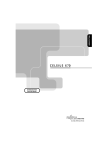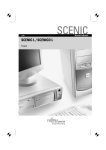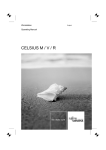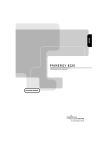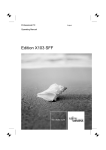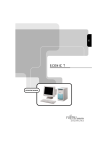Download Fujitsu CELSIUS R630 PC Desktop
Transcript
answers
2
Betriebsanleitung / Operating Manual
CELSIUS R / CELSIUS V
Deutsch / English
Sie haben ...
... technische Fragen oder Probleme?
Wenden Sie sich bitte an:
• unsere Hotline:
Mo-Fr:
8 - 18 Uhr
Sa: 9 - 14 Uhr
Tel.: ++49 (0) 180 3777 000
• Ihren zuständigen Vertriebspartner
• Ihre Verkaufsstelle
Weitere Informationen finden Sie in den Handbüchern "Sicherheit und Ergonomie" und "Garantie".
Aktuelle Informationen zu unseren Produkten, Tipps, Updates usw. finden Sie im Internet:
http://www.fujitsu-siemens.com
Are there ...
... any technical problems or other questions you need clarified?
Please contact:
• your sales partner
• your sales outlet
Further information can be found in the "Safety and Ergonomics" and "Warranty" manuals.
The latest information on our products, tips, updates, etc., can be found on the Internet under:
http://www.fujitsu-siemens.com
Dieses Handbuch wurde auf Recycling-Papier gedruckt.
This manual has been printed on recycled paper.
Ce manuel est imprimé sur du papier recyclé.
Este manual ha sido impreso sobre papel reciclado.
Questo manuale è stato stampato su carta da riciclaggio.
Denna handbok är tryckt på recyclingpapper.
Dit handboek werd op recycling-papier gedrukt.
Herausgegeben von / Published by
Fujitsu Siemens Computers GmbH
Bestell-Nr./Order No.: A26361-K680-Z101-1-7419
Printed in the Federal Republic of Germany
AG 1103 11/03
A26361-K680-Z101-1-7419
Introduction
Important notes
CELSIUS R / CELSIUS V
Preparing for use
Operation
Operating manual
Troubleshooting
and tips
System expansions
Technical data
Index
November 2003 edition
CELSIUS is a registered trademark of Fujitsu Siemens Computers GmbH.
Microsoft, MS, MS-DOS, Windows, and Windows NT are registered trademarks of Microsoft
Corporation.
VESA and DPMS are trademarks of Video Electronics Standards Association.
PS/2 is a registered trademark of International Business Machines, Inc.
Pentium is a registered trademark of Intel Corporation, USA.
Kensington Lock and MicroSaver are registered trademarks of ACCO World Corporation.
All other trademarks referenced are trademarks or registered trademarks of their respective
owners, whose protected rights are acknowledged.
Copyright Fujitsu Siemens Computers GmbH 2003
All rights, including rights of translation, reproduction by printing, copying or similar methods,
in part or in whole, are reserved.
Offenders will be liable for damages.
All rights, including rights created by patent grant or registration of a utility model or design,
are reserved.
Delivery subject to availability. Right of technical modification reserved.
This manual was produced by
cognitas. Gesellschaft für Technik-Dokumentation mbH
www.cognitas.de
Contents
Your CELSIUS R/CELSIUS V...........................................................................................................1
Notational conventions ......................................................................................................................2
Important notes ...............................................................................................................................3
Safety notes ......................................................................................................................................3
Energy saving, disposal and recycling .......................................................................................3
CE marking................................................................................................................................3
FCC Class B Compliance Statement.................................................................................................4
Transporting the workstation..............................................................................................................4
Cleaning the workstation....................................................................................................................4
Preparing for use.............................................................................................................................5
Unpacking and checking the delivery.................................................................................................5
Steps for initial setup .........................................................................................................................5
Setting up the workstation .................................................................................................................6
Connect the monitor, mouse and keyboard .......................................................................................6
Connecting the monitor..............................................................................................................6
Connecting the mouse...............................................................................................................7
Connecting a keyboard ..............................................................................................................7
Connecting the workstation to the mains voltage ...............................................................................8
Initial switch-on: Software will be installed .........................................................................................8
Switching on monitor and workstation........................................................................................9
Installing the software ..............................................................................................................10
Connecting external devices ............................................................................................................10
Connections on the workstation ...............................................................................................11
Connecting external devices to the serial port..........................................................................12
Connecting external devices to the parallel port.......................................................................12
Connecting external devices to the USB ports .........................................................................13
Operation .......................................................................................................................................15
Switching the workstation on....................................................................................................15
Switching off the workstation ...................................................................................................15
Indicators on the workstation ...........................................................................................................16
Keyboard .........................................................................................................................................18
Important keys and key combinations......................................................................................19
Working with floppy disks ................................................................................................................20
Settings in BIOS Setup....................................................................................................................21
Property and data protection............................................................................................................21
Anti-theft protection..................................................................................................................21
Access authorisation via SmartCard ........................................................................................21
Troubleshooting and tips..............................................................................................................23
Installing new software ....................................................................................................................23
Power-on indicator remains unlit after you have switched on your device ........................................23
The screen stays blank....................................................................................................................24
No mouse pointer displayed on the screen ......................................................................................25
The floppy disk cannot be read or written ........................................................................................25
Time and/or date is not correct ........................................................................................................26
Error messages on the screen.........................................................................................................26
Restoring the hard disk contents .....................................................................................................26
Tips ................................................................................................................................................26
A26361-K680-Z101-1-7419
Contents
System expansions....................................................................................................................... 27
Information about boards ........................................................................................................ 27
Opening the casing ......................................................................................................................... 28
Closing the casing........................................................................................................................... 29
Installing and removing a board ...................................................................................................... 30
Installing board with screw ...................................................................................................... 30
Removing board with screw .................................................................................................... 32
Installing board with clip .......................................................................................................... 33
Removing board with clips....................................................................................................... 35
Installing and removing drives ......................................................................................................... 37
Removing the front panel ........................................................................................................ 37
Attaching the front panel ......................................................................................................... 38
Installing an accessible drive................................................................................................... 39
Removing an accessible drive................................................................................................. 41
Changing the floppy disk drive ................................................................................................ 43
Installing or removing the hard disk drive ................................................................................ 45
Installing and removing SmartCard reader (Celsius V only) ............................................................ 48
Installing and removing front USB or USB audio ports .................................................................... 51
Extensions to the mainboard........................................................................................................... 55
Upgrading main memory ......................................................................................................... 55
Replacing processor................................................................................................................ 55
Replacing lithium battery ......................................................................................................... 56
Technical data ............................................................................................................................... 57
Index .............................................................................................................................................. 59
A26361-K680-Z101-1-7419
Your CELSIUS R/CELSIUS V...
...is available with various configuration levels with different hardware and software. In addition, you
can install accessible drives (e.g. DVD drive), hard disks and other boards.
This operating manual tells you how to put your workstation into operation and how to operate it in
daily use. This description applies for all configuration levels. Depending on the configuration level
chosen some of the hardware components described may not be available on your PC. Please
observe the notes on your operating system.
Depending on the configuration selected, the operating system is preinstalled on your hard disk (e.g.
Windows XP).
Your workstation has a number of security features to ensure that no unauthorised persons can
access your data. The security functions in the BIOS Setup also allow you to protect your data by
means of passwords. In addition, you can also mechanically lock your workstation. Systems with a
SmartCard reader offer additional protection.
DeskUpdate allows you under some operating systems to easily and quickly install the latest drivers
and operating system extensions with a few mouse clicks. DeskUpdate is contained on the
"Drivers & Utilities" CD.
Additional information on this workstation is also contained in:
•
•
•
•
•
•
•
in the "Safety and Ergonomics" manual
in the "Warranty" manual
in the operating manual for the monitor
in the technical manual for the mainboard
in the "BIOS Setup" manual
in your operating system documentation
in the information files (e.g. *.TXT, *.DOC, *.WRI, *.HLP)
i
Some of the manuals listed can be found on the "Drivers & Utilities" CD provided with
your computer. These manuals can be read and printed with Acrobat Reader, also
contained on the "Drivers & Utilities" CD.
Keep this operating manual together with your device. If you pass on the device to third parties, you
should include this manual.
A26361-K680-Z101-1-7419
1
Your CELSIUS R/CELSIUS V...
Notational conventions
The meanings of the symbols and fonts used in this manual are as follows:
►
!
indicates information which is important for your health or for preventing physical damage.
i
indicates important information which is required to use the system properly.
Text which follows this symbol describes activities that must be performed in the order shown.
Text in italics indicates commands or menu items.
"Quotation marks" indicate names of chapters or terms.
2
A26361-K680-Z101-1-7419
Important notes
In this chapter you will find information regarding safety which it is essential to take note of when
working with your workstation.
Safety notes
!
Pay attention to the information provided in the "Safety and Ergonomics" manual and in
the following safety notes.
During installation and before operating the device, please observe the instructions on
environmental conditions in the "Technical data" chapter as well as the instructions in the
"Preparing for use" chapter.
You may only operate the device, if the voltage for the device is set to the local mains
voltage (see chapter "Technical data").
The main switch (if present) and the ON/OFF switch do not disconnect the workstation
from the mains voltage. To completely disconnect the mains voltage, remove the power
plug from the grounded mains outlet.
Remove the power plug before opening the unit.
Replace the lithium battery on the mainboard in accordance with the instructions in the
"Extensions to the mainboard" - "Replacing lithium battery" section.
Caution, components in the system can get very hot.
Energy saving, disposal and recycling
Further information can be found on the "Drivers & Utilities" CD provided with your computer.
CE marking
The shipped version of this device complies with the requirements of the EEC directives
89/336/EEC "Electromagnetic compatibility" and 73/23/EEC "Low voltage directive".
A26361-K680-Z101-1-7419
3
Important notes
FCC Class B Compliance Statement
The following statement applies to the products covered in this manual, unless otherwise specified
herein. The statement for other products will appear in the accompanying documentation.
NOTE:
This equipment has been tested and found to comply with the limits for a "Class B" digital device,
pursuant to Part 15 of the FCC rules and meets all requirements of the Canadian InterferenceCausing Equipment Standard ICES-003 for digital apparatus. These limits are designed to provide
reasonable protection against harmful interference in a residential installation. This equipment
generates, uses and can radiate radio frequency energy and, if not installed and used in strict
accordance with the instructions, may cause harmful interference to radio communications.
However, there is no guarantee that interference will not occur in a particular installation. If this
equipment does cause harmful interference to radio or television reception, which can be
determined by turning the equipment off and on, the user is encouraged to try to correct the
interference by one or more of the following measures:
•
•
•
Reorient or relocate the receiving antenna.
Increase the separation between equipment and the receiver.
Connect the equipment into an outlet on a circuit different from that to which the receiver is
connected.
Consult the dealer or an experienced radio/TV technician for help.
•
Fujitsu Siemens Computers GmbH is not responsible for any radio or television interference caused
by unauthorised modifications of this equipment or the substitution or attachment of connecting
cables and equipment other than those specified by Fujitsu Siemens Computers GmbH. The
correction of interferences caused by such unauthorised modification, substitution or attachment will
be the responsibility of the user.
The use of shielded I/O cables is required when connecting this equipment to any and all optional
peripheral or host devices. Failure to do so may violate FCC and ICES rules.
Transporting the workstation
!
Transport all parts separately in their original packaging or in a packaging which protects
them from knocks and jolts, to the new site. Do not unpack them until all transportation
manoeuvres are completed.
Cleaning the workstation
!
Turn off all power and equipment switches and pull the power plug out of the grounded
mains outlets.
The inside of the workstation casing may only be cleaned by authorised, specially trained
personnel.
Do not use any cleaning agents that contain abrasives or may corrode plastic.
Ensure that no liquid enters the system.
Wipe the casing with a dry cloth. If particularly dirty, use a cloth that has been moistened in mild
domestic detergent and then carefully wrung out. Use disinfectant wipes to clean the keyboard and
the mouse.
4
A26361-K680-Z101-1-7419
Preparing for use
!
Please take note of the safety information in the "Important notes" chapter.
Unpacking and checking the delivery
It is recommended not to throw away the original packaging material! It may be required for
reshipment at some later date.
►
Unpack all the individual parts.
►
Check the delivery for damage incurred during transportation.
►
Check whether the delivery agrees with the details in the delivery note.
Should you discover that the delivery does not correspond to the delivery note, notify your local
sales outlet immediately.
Steps for initial setup
Only a few steps are necessary to put your new workstation into operation for the first time:
−
Select location for workstation and set up workstation
−
Connect the monitor, mouse and keyboard
−
Check the voltage at the mains outlet and connect the workstation to an electrical outlet
−
Enable Workstation
You will learn more about the individual steps in the following sections.
i
External devices
If you have received other devices in addition to your workstation (e.g. a printer or a
modem), do not connect these until after the initial installation. The following sections
contain a description of how to connect these external devices: "Connecting external
devices to the serial port" and "Connecting external devices to the parallel port".
Drives and boards
If you have received drives or boards with your Workstation, please do not install them
until after initial installation. How to install drives and boards is described in the "System
expansions" chapter.
A26361-K680-Z101-1-7419
5
Preparing for use
Setting up the workstation
!
When installing your workstation, give consideration to the recommendations and safety
notes in the "Safety and Ergonomics" booklet.
Set up the workstation only in its correct orientation. The points to observe are illustrated
on the following pages.
We recommend that you place your device on a surface with good anti-slip qualities. In
view of the multitude of different finishes and varnishes used on furniture, it is possible
that the rubber feet will mark the surface they stand on.
Do not expose the workstation to extreme environmental conditions (see "Technical data"
chapter).
Provide at least 200 mm of clearance in front of and behind the fan area of the casing to
ensure adequate ventilation. In order to avoid overheating, do not cover the ventilation
area of the monitor or the workstation.
Do not place several workstations one above the other.
Connect the monitor, mouse and keyboard
The ports for the monitor, mouse, and keyboard are on the rear and front (USB ports, optional) of
the workstation.
Keyboard port / purple
PS/2 mouse port / green
Monitor port / blue
USB port / black
Connecting the monitor
►
Follow the instructions contained in the monitor manual to prepare the monitor for operation
(e.g. connecting cables).
►
Plug the data cable into the monitor port
►
Plug the monitor power cable into the grounded mains outlet.
i
6
of the workstation.
The monitor will not be switched off together with the system. Switch off the monitor with
ist own ON/OFF switch.
A26361-K680-Z101-1-7419
Preparing for use
Connecting the mouse
Depending on the equipment level selected, your workstation will be supplied with a PS/2 mouse or
a USB mouse.
Connecting a PS/2 mouse
►
Connect the PS/2 mouse to the PS/2 mouse port
on the workstation.
Connecting USB mouse
►
Connect the USB mouse to the USB port
i
on the workstation.
If you do not attach a mouse at the PS/2 mouse port, you can disable the mouse
controller in the BIOS Setup in order to free the IRQ12 for a different application.
Connecting a keyboard
Depending on the selected equipment level, your workstation will be supplied with a standard
keyboard or a USB keyboard.
Connecting standard keyboard
Use the supplied keyboard cable only.
►
Plug the other end of the keyboard cable (square plug) into the socket on the underside of the
keyboard.
►
Plug the round plug of the keyboard cable into the keyboard port
on the workstation.
Connecting USB keyboard
Use the supplied keyboard cable only.
►
Plug the other end of the keyboard cable (square plug) into the socket on the underside of the
keyboard.
►
Insert the rectangular USB plug of the keyboard cable into the USB port
workstation.
A26361-K680-Z101-1-7419
on the
7
Preparing for use
Connecting the workstation to the mains voltage
Your workstation sets itself automatically to the local rated voltage.
2
1
►
Plug the power cable into the workstation (1).
►
Plug the power plug into the grounded mains outlet (2).
Initial switch-on: Software will be installed
If the workstation is integrated into a network, the user and server details as well as the network
protocol are required. Contact your network administrator if you have any questions about these
settings.
When you switch on your workstation for the first time the supplied software is installed and
configured. You should plan some time for this, as this process must not be interrupted.
!
Once the installation has been started the workstation must not be switched off!
During installation the workstation may only be rebooted when you are requested to do
so!
Otherwise the installation will not be performed correctly. If a fault occurs during the
installation, the contents of the hard disk must be completely restored.
You may require the Windows licence number during installation. This number is located on a
sticker on your workstation.
8
A26361-K680-Z101-1-7419
Preparing for use
Switching on monitor and workstation
►
Switch the monitor on (see the operating manual for the monitor).
►
Switch on the workstation. To do this, follow the instructions below.
2
3
1
Celsius V
Celsius R
1 = ON/OFF switch
2 = LCD display (Celsius V only)
►
1
3 = Power-on indicator (Celsius R only)
Press the ON/OFF switch on the front of the workstation.
Celsius R
The power-on indicator
lights, the workstation is started.
Celsius V
The LCD lights up: The workstation is on. Up to seven symbols are displayed, depending on the
operating state (see chapter “Indicators on the workstation”).
A26361-K680-Z101-1-7419
9
Preparing for use
Installing the software
►
During installation, follow the instructions on screen.
Consult the operating system manual if there is anything unclear about the requested input data.
i
You will find further information about the system, drivers, utilities, updates, manuals etc.
on the "Drivers & Utilities" CD supplied.
Connecting external devices
!
Read the documentation on the external device before connecting it. The power plug must
be removed before connecting external devices, apart from USB devices.
Do not either connect or disconnect cables during storms.
Always take hold of the actual plug. Never unplug a cable by pulling the cable itself.
Connect and disconnect the cables in the order described below.
Connecting cables
•
•
•
Turn off all power and equipment switches.
•
•
Plug all data communication cables into the utility sockets.
Remove all power plugs from the mains outlets.
Connect all cables at the workstation and peripherals. Under all circumstances, please observe
the safety notes provided in the "Important notes" chapter.
Plug all power cables into the grounded mains outlets.
Disconnecting cables
•
•
•
•
Turn off all power and equipment switches.
Remove all power plugs from the mains outlets.
Unplug all data communication cables from the utility sockets.
Disconnect all cables from the workstation and peripherals.
i
10
USB devices are hot-pluggable. This allows cables from USB devices to be connected
and disconnected with the system switched on.
Additional information can be found in the "Connecting external devices to the USB ports"
section and in the documentation for the USB devices.
A26361-K680-Z101-1-7419
Preparing for use
Connections on the workstation
The ports for external devices are on the rear and on the front of the workstation. The ports available
on your workstation depend on the configuration level you have selected. The standard ports are
marked with the symbols shown below (or similar). Exact details of the position of the ports are
supplied in the technical manuals for the boards.
Keyboard port, purple
1
2
Serial port 1, teal or turquoise
Serial port 2, teal or turquoise
Monitor port, blue
Parallel port/Printer, burgundy
Headphones port, orange or light
green
Microphone jack, pink or red
Audio output (Line out), light green
Audio input (Line in), light blue
Game port, gold
SCSI connection
USB - Universal Serial Bus, black
LAN connector
IEEE 1394 FireWire
i
PS/2 mouse port, green
digital
out
Digital audio linie output, yellow
Some of the devices that you connect require special drivers (see the operating system
and device documentation).
A26361-K680-Z101-1-7419
11
Preparing for use
Connecting external devices to the serial port
External devices can be connected to the serial port (e.g. a modem).
►
Connect the data cable to the external device.
►
Connect the data cable to the serial port
.
For an exact description of how to connect external devices to the serial port, please refer to the
device documentation.
i
Settings of the serial port
If you need to change the settings of the serial port (e.g. address, interrupt), you can do
so in the BIOS Setup. The settings for the port are described in the technical manual for
the mainboard or in the "BIOS Setup" manual.
Device drivers
The devices connected to the serial port require drivers. Your operating system already
includes many drivers. Nevertheless, if the driver you need is not on the hard disk, please
install it from the data carrier supplied with the device or with the application programme.
Connecting external devices to the parallel port
External devices can be connected to the parallel port (e.g. a printer).
►
Connect the data cable to the external device.
►
Connect the data cable to the parallel port
.
For an exact description of how to connect external devices to the parallel port, please see the
device documentation.
i
Settings of the parallel port
If you need to change the settings of the parallel port (e.g. address, interrupt), you can do
so in the BIOS Setup. The settings for the port are described in the technical manual for
the mainboard or in the "BIOS Setup" manual.
Device drivers
The devices connected to the parallel port require drivers. Your operating system already
includes many drivers. Nevertheless, if the driver you need is not on the hard disk, please
install it from the data carrier supplied with the device or with the application programme.
12
A26361-K680-Z101-1-7419
Preparing for use
Connecting external devices to the USB ports
You can connect a wide range of external devices to the USB port (e.g. printer, scanner, modem or
keyboard).
i
USB devices are hot-pluggable. This allows cables from USB devices to be connected
and disconnected with the system switched on.
Additional information can be found in the documentation for the USB devices.
►
Connect the data cable to the external device.
►
Connect the data cable to the USB port
i
.
Device drivers
The devices you connect to the USB ports usually require no driver of their own, as the
required software is already included in the operating system. However, if the USB device
requires its own software, please install it from the data carrier provided with the USB
device.
A26361-K680-Z101-1-7419
13
Operation
Switching the workstation on
►
If necessary, switch the monitor on (see the operating manual for the monitor).
►
Press the ON/OFF switch on the front of the workstation.
The corresponding indication appears on the LCD (see chapter "Indicators on the workstation") or
the operating indicator lights, the workstation starts up.
Switching off the workstation
►
Shut down the operating system properly. For Windows: select Shut Down from the Start menu.
►
If the operating system does not automatically switch the workstation off, turn the workstation
ready-to-use when requested to do so by pressing the ON/OFF switch.
If the workstation is ready-to-use, the workstation consumes very little power.
!
►
The ON/OFF switch does not separate the workstation from the mains voltage. To
completely disconnect the mains voltage, remove the power plug from the socket.
If necessary, switch the monitor off (see the operating manual for the monitor).
Placing a workstation (with soft power off function) in a ready-to-operate state by means of
software
With the soft power off function the workstation automatically switches off (standby) or switches into
the energy-saving mode after the operating system is shut down. Requirements: Your system must
support switching off with software and this functionality must be enabled in BIOS Setup. The soft
power off software may also need to be installed on Windows NT systems.
You can also switch your workstation into the standby mode via the DeskView software with the
DeskOff programme.
A26361-K680-Z101-1-7419
15
Operation
Indicators on the workstation
The indicators are on the front of the workstation. Which indicators are available on your workstation
depends on the configuration level you have selected.
1
2
5
3
6
7
3
4
4
Celsius R
Celsius V
Celsius V
1=
2=
3=
4=
Celsius R
LCD / status indicator panel
SmartCard reader indicator
CD-ROM indicator
Floppy disk indicator
5 = Hard disk indicator
6 = Message indicator
7 = Power-on indicator
1 - LCD / status indicator panel (Celsius V only)
The LCD lights up as soon as the workstation is switched on. Up to seven symbols are displayed,
depending on the operating state.
Power on
appears on the LCD as soon as the workstation is switched on.
Standby/ Energy saving mode
appears on the LCD as soon as the workstation is in energy saving mode. The
workstation can be switched on with the ON/OFF switch.
Hard disk
appears on the LCD as soon as the hard disk is accessed.
X
16
Error
appears on the LCD if there is a hardware error in the workstation or if a critical
hardware state is reached (e.g. fan failure, high temperature). You can use
A26361-K680-Z101-1-7419
Operation
DeskView to get detailed information on the problem that occurred. If in any doubt,
consult your administrator.
LAN connection
appears on the LCD as soon as the workstation is connected to a LAN.
LAN access
appears on the LCD as soon as the workstation sends or receives data over the
LAN.
Message
when software that supports this function is used, the appearance of this symbol on
the display indicates that an incoming message (mail, fax) is waiting.
?
Reserved
is reserved for future use.
2 - SmartCard reader indicator (Celsius V only)
The indicator lights up if a SmartCard is inserted.
The indicator flashes if no SmartCard is inserted.
3 - CD-ROM indicator
The indicator lights up when the CD-ROM drive of the workstation is accessed. You may only
remove the CD when the indicator is dark.
4 - Floppy disk indicator
The indicator lights up when the floppy disk drive of the workstation is accessed. You may only
remove the floppy disk when the indicator is unlit.
5 - Hard disk indicator (Celsius R only)
The indicator lights up when the hard disk drive of the workstation is accessed.
6 – Message indicator (Celsius R only)
The indicator glows or flashes when the system has reported a malfunction.
7 - Power-on indicator (Celsius R only)
−
The indicator lights green:
The workstation is on.
−
The indicator lights orange:
The workstation is in energy-saving mode. After being switched on, the workstation
returns to the state it was in before the energy-saving mode.
!
−
In an energy-saving mode the workstation must not be switched off with the
main power switch (if present) or disconnected from the mains, as this may
result in data loss.
The indicator does not light up:
The workstation is disconnected from the power supply or is ready for operation. If the
workstation is ready-to-operate, the workstation can be enabled with the ON/OFF switch.
A26361-K680-Z101-1-7419
17
Operation
Keyboard
1
3
1 = Function keys
2 = Power button (optional)
3 = Alphanumeric keypad
i
18
2
4
5
4 = Cursor keys
5 = Numeric keypad (calculator keypad)
The illustrated keyboard is an example and may differ from the model you use.
A26361-K680-Z101-1-7419
Operation
Important keys and key combinations
The following description of keys and key combinations refers to MS Windows. Details of other keys
and key combinations can be found in the documentation of the relevant application programme.
ON/OFF switch (optional)
Depending on the setting in the BIOS Setup, the system can be switched on, off, or
on and off with this button. Some operating systems allow you to configure
additional functions of the ON/OFF switch in the Control Panel.
On some keyboards the ON/OFF switch can only be used with ACPI. Otherwise the
key is inoperative. The mainboard must support this function.
Enter key
confirms the marked selection. The enter key is also referred to as the "Return" key.
Start key
calls up the Windows Start menu.
Menu key
invokes the menu for the marked item (Windows).
Shift key
enables upper-case letters and the upper key symbols to be used.
Alt Gr
Num
Lock
Ctrl
Ctrl
Alt Gr (e.g. German keyboard)
produces a character shown on the right-hand side of a key (e.g. the character @
on the key Q ).
Num key
Switches the numeric key pad between the number ("Num" indicator lights up) and
the editing modes ("Num" indicator does not light up).
When the Num Lock indicator is lit the digit and comma keys are active.
When the Num Lock indicator is not lit the cursor control functions are active in the
Numeric keypad.
Ctrl key
starts key combination actions. The Strg key is also called "Ctrl", "Control" or
"Control key".
Alt
A26361-K680-Z101-1-7419
Del
Warm boot
restarts the workstation. Press simultaneously the keys Ctrl +
Alt + Del . Under some operating systems the Task Manager
appears first. Then you must press all three keys again to reboot.
19
Operation
Working with floppy disks
i
Follow the instructions supplied by the vendor of the floppy disks.
Never clean the floppy disk drives with cleaning disks. Any attempt would destroy the
read/write head in the disk drive within 20 seconds.
5
4
6
7
1
2
3
1=
2=
3=
4=
5=
6=
7=
Insertion direction
Label area
Write protection tab for a 1.44 Mbyte floppy disk
Identification of a 1.44 MB floppy disk or write protect switch on a 120 MB floppy disk
Eject button for inserted floppy disks
Disk is write-protected
Disk is not write-protected
To insert a diskette
►
Push the floppy disk into the drive in the insertion direction (1) until it engages. The label should
be facing upward.
To remove a diskette
►
Push the eject button (5).
Protect the floppy disk against being overwritten or erased
►
Slide the write-protect slider into position (6). The hole is now visible.
Deactivate write protection
►
20
Slide the write-protect slider into position (7). The hole is now covered.
A26361-K680-Z101-1-7419
Operation
Settings in BIOS Setup
The BIOS Setup menu allows you to set your hardware configuration and system functions of the
workstation. When the PC is delivered, the default entries are valid (see "BIOS Setup" manual and if
necessary technical manual for the mainboard). You may customise these settings to your
requirements in the BIOS Setup.
Property and data protection
Software functions and mechanical locking offer a broad range of functions for protecting your
workstation and your personal data from unauthorised access. You can also combine these
functions.
Anti-theft protection
You can also use this eye (1) to anchor the casing.
1 = Large eye
1
Access authorisation via SmartCard
In systems equipped with a SmartCard reader, access can be restricted to those users who have a
corresponding SmartCard.
A26361-K680-Z101-1-7419
21
Troubleshooting and tips
!
Take note of the safety notes in the "Safety and Ergonomics" manual and in the
"Preparing for use" chapter, when you connect or disconnect cables.
If a fault occurs, try to correct it as described in the following places:
•
•
•
•
in this chapter
in the documentation of the connected devices
in the help systems of the software used
in the documentation of your operating system
If you fail to correct the problem, proceed as follows:
►
Switch off the workstation.
►
Make a note of the steps and the circumstances that led to the fault.
►
Make a note of any error messages displayed.
►
Note the ID number of your device. This number can be found on the type rating plate on the
back of the casing.
►
Contact your sales outlet or our customer service centre.
Installing new software
When installing programmes or drivers, important files may be overwritten and modified. To be able
to access the original data in the event of any problems following installation, you should backup
your hard disk prior to installation.
Power-on indicator remains unlit after you have
switched on your device
This may be due to the following:
The mains voltage supply is faulty
►
Check that the power cable is plugged properly into the workstation and grounded mains outlet.
►
Switch on the workstation.
Internal power supply overloaded
►
Disconnect the power plug of the workstation from the grounded mains outlet.
►
Wait for a moment.
►
Plug the power plug into the grounded mains outlet again.
►
Switch on the workstation.
A26361-K680-Z101-1-7419
23
Troubleshooting and tips
The screen stays blank
If your screen remains blank this may be due to the following:
Monitor is switched off
►
Switch your monitor on.
Power saving has been activated (screen is blank)
►
Press any key on the keyboard.
or
►
Deactivate the screen saver. Enter the appropriate password.
Brightness control is set to dark
►
Adjust the brightness control. For detailed information, please refer to the operating manual
supplied with your monitor.
Power cable not connected
►
Switch off the monitor and the workstation.
►
Check whether the power cable of the monitor is properly connected to the monitor and to the
mains outlet.
►
Check that the power cable of the workstation is plugged properly into the workstation and
grounded mains outlet.
►
Switch on the monitor and the workstation.
Monitor cable not connected
►
Switch off the monitor and the workstation.
►
Check that the monitor cable is properly connected to the workstation and monitor.
►
Switch on the monitor and the workstation.
Wrong monitor has been set under Windows 2000
►
Restart the workstation.
►
If the message Starting Windows appears, press function key F8
The Windows 2000 Advanced Options Menu appears.
►
Select Safe Mode or Safe Mode with Network.
►
Set the correct values for the attached monitor as described in the operating manual of the
monitor by selecting Start - Settings - Control Panel - Display - Settings.
24
A26361-K680-Z101-1-7419
Troubleshooting and tips
Wrong monitor has been set under Window XP
►
Restart the workstation.
►
Press F8 while the system is booting.
Either the Windows Advanced Start Options menu or the menu for selecting the operating system
appears.
►
If the menu for selecting the operating system appears, press F8 .
►
Select Safe Mode or Safe Mode with Network.
►
Set the correct values for the attached monitor as described in the operating manual of the
monitor by selecting Start - Settings - Control Panel - Display and then the Appearance, Themes,
Settings tabs.
The wrong RAM modules have been inserted
See the technical manual for the mainboard for information on which memory modules can be used.
No mouse pointer displayed on the screen
►
Shut down the operating system properly.
►
Switch off the workstation.
►
Check that the mouse cable is properly connected to the system unit.
If you use an adapter or extension lead with the mouse cable, check the connections.
►
Make sure that only one mouse is connected.
►
Switch on the workstation.
The mouse controller must be enabled if you use a PS/2 mouse on the PS/2 mouse port
.
►
Check in the BIOS Setup that the mouse controller is Enabled.
►
Check that the mouse driver is properly installed and is present when the application
programme is started. Detailed information can be found in the user guide for the mouse and
application programme.
The floppy disk cannot be read or written
►
Check that the write protection of the floppy disk or the floppy disk drive is activated (refer to
the "BIOS Setup" manual and if necessary to the technical manual for the mainboard).
►
Check the entry for Diskette A: in the Main menu of the BIOS Setup.
►
Check that the floppy disk drive controller is enabled (also refer to the technical manual for the
mainboard or to the "BIOS Setup" manual).
►
Check that the cables of the floppy disk drive are properly connected (refer to "Changing the
floppy disk drive" chapter).
A26361-K680-Z101-1-7419
25
Troubleshooting and tips
Time and/or date is not correct
You can set the time and date in the BIOS Setup or in the operating system.
►
Set the time and date.
If the time and date are repeatedly wrong when you switch on your PC, the on-board
battery is flat. Change the lithium battery as described in the "Extensions to the
mainboard" - "Replacing lithium battery" chapter.
i
Error messages on the screen
Error messages and their explanation are contained:
•
•
•
in the technical manual for the mainboard
in the "BIOS Setup" manual
in the documentation for the programmes used
Restoring the hard disk contents
Should you need to restore your hard disk, the instructions are provided on the case of the
"Recovery CD" (delivered with your system).
Tips
The workstation cannot be switched off with the ON/OFF switch
Cause: The workstation has not been switched on with the ON/OFF switch.
►
Press the ON/OFF switch again.
Cause: System crash
►
Press and hold the power button for at least four seconds until the workstation switches off.
Out of system resources
If you have too many applications running at once, you may experience problems due to a lack of
system resources. In this case you should:
►
close unnecessary applications
or
►
run the applications in a different order
Other manuals
Other manuals are contained on the "Drivers & Utilities" CD.
26
A26361-K680-Z101-1-7419
System expansions
!
It may be necessary to update the BIOS when carrying out a system expansion or
hardware upgrade. Additional information is contained in the "BIOS Setup" manual or
possibly in the technical manual for the mainboard.
When installing components that become very hot, make sure that the maximum
permissible temperatures of the individual components are not exceeded.
The workstation must be switched off when installing/removing the system expansions
and may not be in the energy-saving mode.
Remove the power plug before opening the workstation.
This chapter describes all the activities required to modify your workstation hardware (e.g. installing
boards or drives).
Read the supplied documentation before installing new drives and/or boards.
Refer to the technical manual for the mainboard before making any extensions to the mainboard.
Information about boards
Take care with the locking mechanisms (catches and centring pins) when you are replacing boards
or components on boards.
To prevent damage to the board or the components and conductors on it, please take care when
you insert or remove boards. Make sure expansion boards are inserted straightly.
Never use sharp objects (screwdrivers) for leverage.
Boards with electrostatic sensitive devices (ESD) are identifiable by the
label shown.
When you handle boards fitted with ESDs, you must, under all
circumstances, observe the following points:
A26361-K680-Z101-1-7419
•
You must statically discharge yourself before working with boards (e.g.
by touching a grounded object).
•
•
•
•
The equipment and tools you use must be free of static charges.
Pull out the power plug before inserting or removing boards.
Always hold boards with ESDs by their edges.
Never touch pins or conductors on boards fitted with ESDs.
27
System expansions
Opening the casing
►
Switch off the workstation. The workstation must not be in the energy-saving mode.
!
Please take note of the safety information in the "Important notes" chapter.
Pull the power plug out of the mains outlet.
Only insert the power plug after you have closed the casing.
►
Remove any connected cables in the unit that obstruct you.
►
Place the device in a convenient working position.
a
►
Slide the side cover approximately 2 cm (a) in the direction of the arrow (1), until the stop.
►
Unhook the upper edge of the side cover from the casing.
►
Pull the side cover in the direction of the arrow of the casing.
28
A26361-K680-Z101-1-7419
System expansions
Closing the casing
a
►
Hook the side cover into the lower guide trail in the casing (1). Make sure that the side cover is
offset by approximately 2 cm (a).
►
Engage the top edge of the side cover on the casing.
►
Push the side cover as far as it will go in the direction of the arrow (2).
A26361-K680-Z101-1-7419
29
System expansions
Installing and removing a board
!
Please take note of the section "Information about boards".
The number, position and arrangement of the board slots on the mainboard can be found in the
technical manual for the mainboard. Boards may already be installed when the device is shipped.
You can fix boards in two ways:
•
•
with screws
with the clip
Installing board with screw
►
Open the casing (see "Opening the casing" chapter).
2
1
►
Loosen the screw (1).
►
Remove the cover plate from the slot (2).
!
►
30
Do not dispose of the cover plate. For cooling, protection against fire and in order to
comply with EMC regulations, you must refit the cover plate if you remove the board.
Make the required settings for the board.
A26361-K680-Z101-1-7419
System expansions
2
1
►
Push the board up to its slot (1) as far as the stop.
►
Press the board into the slot so that it engages.
►
Fasten the board into place with the screw (2).
►
If necessary, connect the cables.
►
Close the casing (see "Closing the casing" chapter).
i
If you have installed or removed a PCI board, please check the relevant PCI slot settings
in the BIOS Setup. If necessary, change the settings. Further information is provided in the
PCI board documentation.
A26361-K680-Z101-1-7419
31
System expansions
Removing board with screw
►
Open the casing (see "Opening the casing" chapter).
►
Disconnect the cables connected to the board.
1
2
►
Loosen the screw (1).
►
Remove the board from the casing (2).
!
32
For cooling, protection against fire, and in order to comply with EMC (electromagnetic
compatibility) regulations, you must refit the cover plate.
A26361-K680-Z101-1-7419
System expansions
1
2
►
Push the rear slot cover plate into the slot (1). Ensure that the point of the cover engages on
the outside of the casing.
►
Fasten the rear slot cover plate with the screw (2).
►
Close the casing (see "Closing the casing" chapter).
If you have installed or removed a PCI board, please check the relevant PCI slot settings
in the BIOS Setup. If necessary, change the settings. Further information is provided in the
PCI board documentation.
i
Installing board with clip
►
Open the casing (see "Opening the casing" chapter).
2
1
2
►
Press on the clip (1) in the direction of the arrow and unhook it.
►
Pull off the clip (2).
A26361-K680-Z101-1-7419
33
System expansions
►
Remove the cover plate from the slot (2).
!
►
Do not dispose of the cover plate. For cooling, protection against fire and in order to
comply with EMC regulations, you must refit the cover plate if you remove the board.
Make the required settings for the board.
a
2
1
►
Push the board up to its slot (1) as far as the stop.
►
Press the board into the slot so that it engages.
►
Put the clip on. Make sure that the pin (a) is inserted into the screw hole.
►
Press the clip in the direction of the arrow (2). Make sure that the clip engages when released.
►
If necessary, connect the cables.
►
Close the casing (see "Closing the casing" chapter).
i
34
If you have installed or removed a PCI board, please check the relevant PCI slot settings
in the BIOS Setup. If necessary, change the settings. Further information is provided in the
PCI board documentation.
A26361-K680-Z101-1-7419
System expansions
Removing board with clips
►
Open the casing (see "Opening the casing" chapter).
►
Disconnect the cables connected to the board.
3
1
2
►
Press the clip in the direction of the arrow (1) and unhook it.
►
Pull off the clip (2).
►
Remove the board from the casing (3).
!
For cooling, protection against fire, and in order to comply with EMC (electromagnetic
compatibility) regulations, you must refit the cover plate.
A26361-K680-Z101-1-7419
35
System expansions
a
1
2
►
Push the rear slot cover plate into the slot (1). Ensure that the point of the cover engages on
the outside of the casing.
►
Put the clip on. Make sure that the pin (a) is inserted into the screw hole.
►
Press the clip in the direction of the arrow (2). Make sure that the clip engages when released.
►
Close the casing (see "Closing the casing" chapter).
i
36
If you have installed or removed a PCI board, please check the relevant PCI slot settings
in the BIOS Setup. If necessary, change the settings. Further information is provided in the
PCI board documentation.
A26361-K680-Z101-1-7419
System expansions
Installing and removing drives
The PC casing can accommodate a total of eight drives:
•
four accessible drives
(three 5¼" drives and one 3½" drive)
•
four non-accessible drives
(3½" drives)
"Accessible drives" are e.g. DVD or CD ROM drives, into which a data carrier can be inserted from
outside. Non-accessible drives are e.g. hard disk drives.
IDE drives
Four IDE drives are supported as standard equipment. Ideally, hard disks are connected to IDE
interface 1 and other drives to IDE interface 2 (see also the technical manual for the mainboard).
SCSI drives
If you want to install a SCSI drive, you require a SCSI controller and a SCSI cable. Details are
provided in the manuals on the SCSI controller
Removing the front panel
►
Open the casing (see "Opening the casing" chapter).
a
►
Detach the three locking tabs on the left side of the front panel (1).
►
Open the left side of the front panel approximately 2-3 cm (a).
A26361-K680-Z101-1-7419
37
System expansions
►
Pull the front panel off in the direction of the arrow. If you pull too firmly, the LCD cable may be
pulled off the Celsius V or damaged.
i
In a system with an LCD, the cable is long enough so that you can carefully place it to one
side with the front panel. You do not need to unplug the cable before removing the front
panel.
Attaching the front panel
►
Engage the three hinges on the right side of the front panel (1).
►
Close the front panel on the casing so that the three locking tabs on the left side of the front
panel engage (2). On the CelsiusV you must make sure that the LCD cable is not pinched.
►
Close the casing (see "Closing the casing" chapter).
38
A26361-K680-Z101-1-7419
System expansions
Installing an accessible drive
►
Open the casing (see "Opening the casing" chapter).
►
Remove the front (see "Removing the front panel" chapter).
►
Pull the empty slide-in module out of the
casing.
1
2
1
1
2
1
►
Loosen the screws (1).
►
Remove the rails from the cover (2).
i
Do not throw away the cover of the empty slide-in module. For cooling, protection against
fire, and in order to comply with EMC regulations, you must refit the empty slide-in module
if you remove the drive again later.
►
Take the new drive out of its packaging.
►
Adjust the required settings on the drive (if necessary, on already-installed drives as well).
A26361-K680-Z101-1-7419
39
System expansions
2
1
2
2
1
2
►
Lay the rails onto the drive such that the holes in them align with the screw holes (1).
►
Fasten the rails with the screws (2).
►
Slide the accessible drive into the casing.
►
Plug the data and the power supply connectors into the drive. Make sure the polarity is correct.
►
Attach the front panel (see "Attaching the front panel").
►
Close the casing (see "Closing the casing" chapter).
i
40
It may be necessary to modify the entry for the drive in the BIOS Setup.
A26361-K680-Z101-1-7419
System expansions
Removing an accessible drive
►
Open the casing (see "Opening the casing" chapter).
►
Remove the front (see "Removing the front panel" chapter).
►
Pull the data and the power supply connectors from the desired drive.
►
►
Pull the drive out of the casing.
If necessary, make the required settings on the remaining hard disk drive.
1
2
1
2
1
►
Loosen the screws (1).
►
Remove the rails from the drive (2).
A26361-K680-Z101-1-7419
1
41
System expansions
2
1
2
2
1
2
►
Lay the rails onto the blanking plate such that the holes in them align with the screw holes (1).
►
Fasten the rails with the screws (2).
►
Slide the empty slide-in module into the
casing.
►
Attach the front panel (see "Attaching the front panel").
►
Close the casing (see "Closing the casing" chapter).
i
42
It may be necessary to modify the entry for the remaining drives in the BIOS Setup.
A26361-K680-Z101-1-7419
System expansions
Changing the floppy disk drive
►
Open the casing (see "Opening the casing" chapter).
►
Remove the front (see "Removing the front panel" chapter).
►
Disconnect the cables connected to the floppy disk drive.
►
If it is present, pull the cable of the front USB or USB-audio interface from the mainboard (see
also the technical manual for the mainboard").
Removing the floppy disk drive
2
►
Loosen the screws (1).
►
Pull the slide-in module out of the casing (2).
A26361-K680-Z101-1-7419
1
43
System expansions
1
2
1
►
Remove the screws (1) on both sides of the drive.
►
Pull the disk drive out of the slide-in module (2).
Installing the floppy disk drive
►
Take the new floppy disk drive out of its packaging.
2
1
2
►
If necessary, feed the cables for the USB or USB audio ports through the slide-in module slot
into the inside of the unit.
►
Slide the floppy disk drive into the slide-in module (1).
►
Fasten the floppy disk drive with the screws (2) on both sides of the drive.
44
A26361-K680-Z101-1-7419
System expansions
1
2
►
Slide the slide-in module into the casing (1).
►
Secure the slide-in module with the screws (2).
►
Fit the data and power supply connectors to the floppy disk drive.
►
If it is present, pull the cable of the front USB or USB-audio interface from the mainboard (see
also the technical manual for the mainboard).
►
Attach the front panel (see "Attaching the front panel").
►
Close the casing (see "Closing the casing" chapter).
i
It may be necessary to modify the entry for the drive in the BIOS Setup.
Installing or removing the hard disk drive
►
Open the casing (see "Opening the casing" chapter).
►
Remove the front (see "Removing the front panel" chapter).
A26361-K680-Z101-1-7419
45
System expansions
Installing a hard disk drive
►
Take the new hard disk drive out of its packaging.
►
Make the required settings (e.g. master-slave settings) on the drive.
►
Secure the EasyChange rails on the side of the
hard disk by inserting the upper pins of the
EasyChange rail in the corresponding holes of the
hard disk.
1
►
Push the hard disk drive into the casing (1) until the EasyChange rails engage.
►
Connect the data and power supply cables to the hard disk drive or to the hard disk drives.
i
Connect the blue plug of the data cable to the connection on the mainboard. Connect the
plug on the other end to the hard disk drive.
►
Attach the front panel (see "Attaching the front panel").
►
Close the casing (see "Closing the casing" chapter).
i
46
It may be necessary to modify the entry for the drive in the BIOS Setup.
A26361-K680-Z101-1-7419
System expansions
Removing a hard disk drive
►
Disconnect all cables connected to the drive (data cable, power supply cable).
1
2
1
►
Press the EasyChange rails in the direction of the arrows (1).
►
Pull the hard disk drive out of the carrier (2).
►
Pull the EasyChange rails off the hard disk
drive.
►
If necessary, make the required settings on
the remaining hard disk drive.
►
Attach the front panel (see "Attaching the front panel").
►
Close the casing (see "Closing the casing" chapter).
i
It may be necessary to modify the entry for the drive in the BIOS Setup.
A26361-K680-Z101-1-7419
47
System expansions
Installing and removing SmartCard reader (Celsius V
only)
In systems equipped with a SmartCard reader, access can be restricted to those users who have a
corresponding SmartCard.
Installing a SmartCard reader for the first time
►
Open the casing (see "Opening the casing" chapter).
►
Remove the front (see "Removing the front panel" chapter).
►
Pull the empty slide-in module out of the
casing.
On the inside of the slide-in module, the slot for the SmartCard is protected with a plastic bar on
delivery.
a
48
A26361-K680-Z101-1-7419
System expansions
►
Break off the plastic (a) tag.
Installing a SmartCard reader
►
Open the casing (see "Opening the casing" chapter).
►
Remove the front (see "Removing the front panel" chapter).
►
Pull the slide-in module out of the casing.
2
2
a
a
1
►
Push the SmartCard reader- with the component side facing downwards - in the direction of the
arrow (1) into the guide (a].
►
Screw the SmartCard reader to the carrier (2).
A26361-K680-Z101-1-7419
49
System expansions
►
Push the SmartCard reader as far as
possible into the casing in the direction of
the arrow.
►
Attach the SmartCard reader cable to the mainboard connector (see the technical manual for
the mainboard).
►
Attach the front panel (see "Attaching the front panel").
►
Close the casing (see "Closing the casing" chapter).
Removing a SmartCard reader
►
Open the casing (see "Opening the casing" chapter).
►
Remove the front (see "Removing the front panel" chapter).
►
Disconnect the plug of the SmartCard data cable from the mainboard (see the technical manual
for the mainboard).
►
Pull the SmartCard reader out of the casing in the direction of the arrow (1) (see "Installing
SmartCard reader").
1
►
Loosen the screws (1).
►
Pull the SmartCard reader out of the
carrier in the direction of the arrow (2).
1
2
►
If you do not want to install a new SmartCard reader, push the slide-in module into the casing
again (see "Installing SmartCard reader").
►
Attach the front panel (see "Attaching the front panel").
►
Close the casing (see "Closing the casing" chapter).
50
A26361-K680-Z101-1-7419
System expansions
Installing and removing front USB or USB audio
ports
In the gap beside the floppy disk drive, two USB ports or one USB port combined with two audio
ports can be installed (headphone out, microphone in).
Installing front USB or USB audio ports
►
Open the casing (see "Opening the casing" chapter).
►
Remove the front (see "Removing the front panel" chapter).
►
Disconnect the cables from the floppy disk drive.
2
►
Loosen the screws (1).
►
Pull the slide-in module out of the casing (2).
A26361-K680-Z101-1-7419
1
51
System expansions
1
2
►
First engage the tab (1).
►
Fasten the USB or USB audio ports with the screw (2).
►
Feed the cables for the USB or USB audio ports through the slide-in module slot into the inside
of the unit.
1
2
►
Slide the floppy disk drive into the slide-in module (1).
►
Fasten the floppy disk drive with the screws (2) on both sides of the drive.
►
Fit the data and power supply connectors to the floppy disk drive.
►
Connect the USB cable and, if necessary, the audio cable to the corresponding connector on
the mainboard (see also the technical manual for the mainboard).
52
A26361-K680-Z101-1-7419
System expansions
►
Remove the blanking plate for the USB or USB audio ports from the front panel.
►
Insert the appropriate ports frame for the USB or USB audio ports into the front panel.
i
The USB interface and the USB-audio interface each have a separate interface frame.
►
Attach the front panel (see "Attaching the front panel").
►
Close the casing (see "Closing the casing" chapter).
Removing front USB or USB audio ports
►
Open the casing (see "Opening the casing" chapter).
►
Remove the front (see "Removing the front panel" chapter).
►
Detach the USB data cable and, if present, the audio data cable from the mainboard (see the
technical manual for the mainboard).
►
Disconnect the cables from the floppy disk drive.
2
►
Loosen the screws (1).
►
Pull the slide-in module out of the casing (2).
A26361-K680-Z101-1-7419
1
53
System expansions
2
1
►
Remove the screw (1) and then remove the USB or USB-audio interface (2).
1
2
►
Slide the floppy disk drive into the slide-in module (1).
►
Fasten the floppy disk drive with the screws (2) on both sides of the drive.
►
Fit the data and power supply connectors to the floppy disk drive.
►
Remove the ports frame for the USB or USB audio ports from the front panel.
►
Insert the blanking plate for the USB or USB audio ports into the front panel.
►
Attach the front panel (see "Attaching the front panel").
►
Close the casing (see "Closing the casing" chapter).
54
A26361-K680-Z101-1-7419
System expansions
Extensions to the mainboard
Details on whether you can upgrade the main memory or the processor are provided in the technical
manual for the mainboard.
►
Open the casing (see "Opening the casing" chapter).
Upgrading main memory
►
Upgrade the memory according to the description in the technical manual for the mainboard.
►
Close the casing (see "Closing the casing" chapter).
Replacing processor
►
Upgrade the processor according to the description in the technical manual for the mainboard.
A26361-K680-Z101-1-7419
55
System expansions
Replacing lithium battery
In order to permanently save the system information, a lithium battery is installed to provide the
CMOS-memory with a current. A corresponding error message notifies the user when the charge is
too low or the battery is empty. The lithium battery must then be replaced.
!
Incorrect replacement of the lithium battery may lead to a risk of explosion!
The lithium battery may be replaced only with an identical battery or with a type
recommended by the manufacturer.
Do not throw lithium batteries into the household waste. They must be disposed of in
accordance with local regulations concerning special waste.
Make sure that you insert the battery the right way round. The plus pole must be on the
top!
The lithium battery holder exists in different designs that function in the same way.
3
2
4
2
1
3
►
Press the locking lug in the direction of the arrow; the battery jumps somewhat out of the
holder (1).
►
Remove the battery (2).
►
Push the new lithium battery of the identical type into the holder (3) and press it downward until
it engages (4).
►
Close the casing (see "Closing the casing" chapter).
56
A26361-K680-Z101-1-7419
Technical data
Electrical data
Regulations complied with:
EN60950/VDE0805, UL 1950, CSA 22.2
No. 950
Protection class:
I
Rated voltage range
100 V -240 V
Frequency:
50 - 60 Hz
Max. rated current
100 V -127 V: 6 A
200 V - 240 V: 3 A
Dimensions
Width/depth/height:
205 mm x 560 mm x 445 mm
Weight
with the basic configuration
approx. 25 kg
Environmental conditions
Environment class (3K2)
Environment class (2K2)
DIN IEC 721 part 3-3
DIN IEC 721 part 3-2
Temperature:
Operating (3K2)
Transport (2K2)
15 °C .... 35 °C
-25 °C .... 60 °C
•
•
Condensation in operating must be avoided.
Clearance required to ensure adequate ventilation
•
•
front
rear
A26361-K680-Z101-1-7419
200 mm
200 mm
57
Index
3 1/2-inch drive 37
5 1/4-inch drive 37
A
Access permission, SmartCard 21
Alt Gr key 19
Anti-theft protection 21
Audio input 11
Audio output 11
B
Battery 56
BIOS Setup 21
system settings 21
Board 27
installing 30
installing with clip 33
installing with screw 30
removing 30
removing with clip 35
removing with screw 32
Button
ON/OFF switch 19
C
Cable
connecting 10
disconnecting 10
Casing
closing 29
opening 28
CD-ROM
indicator 17
CD-ROM drive
installing 37, 38, 39
removing 41
CE certificate 3
Chain 21
Class B Compliance Statement 4
Clearance 57
Configuration, BIOS Setup 21
Contents of delivery 5
Control key 19
Courier 2
Ctrl key 19
Ctrl+Alt+Del 19
Cursor keys 18
A26361-K680-Z101-1-7419
D
Data
dimensions 57
environmental 57
weight 57
Data protection 21
Date
not correct 26
Device drivers
parallel port 12
serial port 12
USB 13
Devices
connecting 10, 12, 13
ports 11
Digital audio output 11
Dimensions 57
Drive 37
accessible 37
installing 37, 38, 39
non-accessible drive 37
removing 37, 41
E
Electromagnetic compatibility 3
Energy saving 3
Enter key 19
Environmental conditions 57
Environmental data 57
Ergonomics 6
Error
date 26
floppy disk 25
message 26
mouse 25
screen 24
time 26
workstation 23
ESD 27
Extensions
mainboard 55
workstation 27
External devices
connecting 10, 12, 13
ports 11
59
Index
F
FCC statement 4
FireWire 11
Floppy disk
cannot read 25
cannot write 25
indicator 17
inserting 20
removing 20
working with 20
write-protection 20, 25
write-protection, disabling 20
Floppy disk drive
changing 43
indicator 17
installing 44
removing 43
Function keys 18
G
Game port 11
H
Hard disk contents, restoring 26
Hard disk drive
indicator 17
installing 45, 46
removing 45, 47
replacing 45
Hard disk indicator 17
Headphones, port 11
I
IDE drive 37
Installation
switching on for the first time 8
Installing
accessible drive 37, 38
CD-ROM drive 37
software 8, 10
Interfaces 11
Italics 2
60
K
Key
Alt Gr 19
Control key 19
Ctrl 19
Ctrl key 19
Ctrl+Alt+Del 19
Enter key 19
Menu key 19
Num Lock 19
Return key 19
Shift 19
Shift key 19
Start key 19
Key combination 19
Keyboard 18
connecting 7
important keys 19
port 11
Keyboard port 6, 7
Keypad
alphanumeric 18
L
LAN port 11
LCD 16
Line in 11
Line out 11
Lithium battery 55
replacing 56
M
Main memory 55
upgrading 55
Mainboard, extensions 55
Manuals, further 26
Memory
insufficient 26
not enough 26
Menu key 19
Message indicator 17
Microphone jack 11
Monitor
connecting 6
remains blank 24
transporting 4
Monitor port 6
A26361-K680-Z101-1-7419
Index
Monitor screen
no screen display 24
Mouse
connecting 7
error 25
port 11
Mouse pointer 25
Mouse port 6
N
New installation, software 23
New software, installing 23
Notational conventions 2
Note
boards 27
CE certificate 3
energy saving 3
important 3
safety 3
Num Lock key 19
Numeric keypad 18
O
ON/OFF switch 9, 19
P
Packing material 5
unpacking 5
Parallel port 11, 12
connecting devices 12
settings 12
Port
audio input 11
audio output 11
game port 11
headphones 11
keyboard 11
line in 11
line out 11
microphone 11
monitor 11
mouse 11
parallel port 11
printer 11
PS/2 mouse 11
SCSI 11
serial port 11
USB 11
Power-on indicator 9, 17
dark 23
fails to light 17, 23
flashes 17
lights green 17
lights orange 17
A26361-K680-Z101-1-7419
Preparing for first use, overview 5
Preparing for use 5
overview 5
Printer 11
Processor 55
replacing 55
Property protection 21
Protection
property and data 21
PS/2 mouse
connecting 7
port 11
PS/2 mouse port 6, 7
R
Ready-to-operate 9
Retransportation 4
Return key 19
S
Safety 3
SCSI drive 37
SCSI port 11
Security functions
SmartCard 21
Serial port 11, 12
connecting devices 12
port 11
settings 12
Setup, see BIOS Setup
Shift key 19
Signs and symbols 2
SmartCard reader 48
indicator 17
installing 48, 49
removing 48, 50
Soft power off 15
Software
installing 8, 10
new installation 23
Standard keyboard, connecting 7
Start key 19
Streamer
installing 37, 38, 39
removing 41
Summer time 26
Surface 57
System expansion 27
System settings, BIOS Setup 21
61
Index
T
Technical data 57
Time
not correct 26
Time, daylight savings 26
Tips 23, 26
Transport 4
Trouble
floppy disk 25
mouse 25
screen 24
workstation 23
Troubleshooting 23
U
USB 6
USB devices
connecting 13
software 13
USB keyboard, connecting 7
USB mouse, connecting 7
USB port 7, 13
connecting devices 13
USB ports
installing 51
removing 53
USB, port 11
62
V
Ventilation area 6, 57
Video workstation 6
W
Warm boot 19
Weight 57
Workstation
anti-theft protection 21
cabling 10
cannot boot 23
checking rated voltage 8
cleaning 4
closing 29
connecting 8
connecting devices 10
extensions 27
indicators 16
opening 28
ports 11
ready-to-operate 15
setting up 6
soft power off 15
switching off 15
devices with main power
switch 15
switching on 9, 15
transporting 4
Write protection, floppy disk 20, 25
A26361-K680-Z101-1-7419







































































